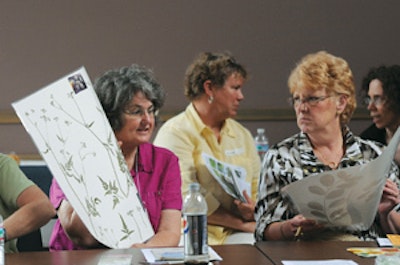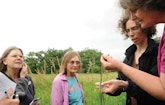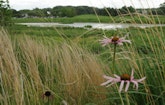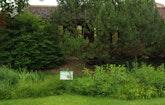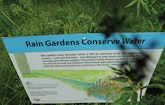Interested in Stormwater?
Get Stormwater articles, news and videos right in your inbox! Sign up now.
Stormwater + Get AlertsPatsy Mortimer is not a municipal employee, but she does work closely with several municipal organizations. Mortimer, coordinator for the Flint Creek Watershed Partnership (FCWP), won the 2010 Stewardship of the Year Award from the Lake County Stormwater Management Commission (LCSMC).
With the humility typical of a civic volunteer, she notes, “Well, sure, my name is on the certificate, but the award is really a testament to all of us here at FCWP.”
Mike Warner, executive director of LCSMC disagrees. “Patsy’s integrity and compassion are hallmarks of a true steward of the land,” he said during the award presentation. He and Mortimer agree the award was based on years of service toward their mutual goals – restoring and renovating the watershed to its predevelopment state, and protecting groundwater recharge areas.
“There wasn’t really any single project or accomplishment that triggered the award,” Mortimer says. “It was more a cumulative recognition for all that we’ve done since the FCWP was created back in 2005.” She runs the FCWP out of a home office, moonlighting as an independent general contractor, but that leaves enough discretionary time to make the FCWP into the success it has become.
Development impacts
The Flint Creek watershed was originally a combination of pristine savanna, prairie and wetlands. As the area developed, things began to change. Invasive species were altering the ecosystem for the worse, and groundwater recharge areas were showing signs of contamination from agricultural and urban runoff.
The Barrington Area Development Council, which goes back to the early 1960s, first identified the issues affecting Flint Creek. They called on several organizations for proposals, and one of them was Citizens for Conservation (CFC), on which Mortimer holds a board position.
CFC proposed the creation of the FCWP to address the problems, pointing out that Flint Creek could not be dealt with in isolation — it was necessary to look at the watershed as an ecosystem. The Development Council agreed, and the FCWP was born.
Initial funding came in part from the Governor of Illinois and the state Environmental Protection Agency under the Clean Water Act. Additional funding came from the Barrington Area Council of Governments, Barrington Area Development Council, Barrington Hills Conservation Trust, CFC, the townships of Barrington and Cuba, and the villages of Barrington, Barrington Hills, Hawthorn Woods, Lake Barrington, Lake Zurich and North Barrington.
CFC is a nonprofit organization that acts as fiscal agent for the FCWP. It’s a convenient arrangement that allows the FCWP to focus on actual projects instead of funding and legal matters.
“We take care of all financial transactions for the FCWP, including grants, dues, and audits, as well as correspondence, legal questions, and contracts,” says Sam Oliver, CFC staff director. CFC is also fiscal agent for the Spring Creek Watershed Project, which has interests similar to those of the FCWP.
First rain garden
One of the FCWP’s first major projects was a demonstration rain garden at the Barrington Area Library. Installed, and still maintained at no charge by Trillium Native Landscape, it serves as an educational resource while mitigating runoff from a facility with a large impervious area.
The rain garden was designed to handle runoff from 2,000 square feet of roof and is built around a 3-inch riser into a storm drain. “Normally, we want the water to seep into the ground instead of going right into the storm drain, but that riser is a backup for when heavy rains exceed the garden’s capacity,” says Trillium co-owner Kevin Rische.
Construction meant excavating 300 square feet of soil to a depth of 30 inches, as some of the subsoil was not well suited for drainage. “We added about 30 percent decomposed leaf litter to that soil,” notes Rische. “That not only improves the drainage, but also creates a good planting medium.”
Plants were selected based on moisture tolerance. Near the edges of the garden, where conditions are typically dryer, Rische used butterfly milkweed, prairie dropseed, and nodding wild onion. In the deeper areas, where water often pools, plants included blue flag iris, cardinal flower, and a variety of sedges.
Workshop payoff
Citizens who attend FCWP workshops are offered free consultations, done by Trillium, to solve drainage issues on their properties. Sometimes the homeowners are interested purely in aesthetics, but in other cases there are water problems. “In all cases, these people want to contribute in some way, whether to help restore groundwater supplies or provide habitat for local fauna,” Rische says.
After an on-site inspection, Trillium makes recommendations about where to locate the rain garden, how large it needs to be, and what types of plants to incorporate. Sometimes the solution is as simple as using a rain barrel or bioswale.
Says Mortimer, “You wouldn’t think a single 55-gallon rain barrel would make that much difference, but that’s 55 gallons of water that can be used for irrigation, and 55 gallons less you have to pull up out of the aquifer. I have three rain barrels at my house.”
Rische notes, “In the past two years we’ve done 25 consultations. About half of those resulted in some kind of project. Seven have resulted in full-blown rain gardens.”
The FCWP’s other work has included detention basin retrofits, prescribed burns, and spot herbicide treatments targeting invasive plants. Much of the work is focused on the restoration of natural areas to their original native prairie state.
Trouble with recharge
Public feedback shows that many residents of the watershed think their drinking water comes from Lake Michigan. The actual source is the local aquifer, and that’s why groundwater recharge areas, rain gardens, and runoff mitigation matter so much.
Notes Mortimer, “The Flint Creek Watershed is really a subwatershed of the larger Fox River, and there are people downstream who use the Fox River for their potable water supply, so what we do here affects more than just area residents. A large part of the problem is we’ve been getting hundred-year storms here pretty much every year. Last May we had three inches of rain that came in at a rate of 12 inches per hour, and that caused significant runoff issues.”
The FCWP has so far focused its educational programs at adults. These have included workshops on the proper location and construction of rain gardens, effective use of rain barrels, and general programs relating to public awareness and stewardship.
Mortimer observes, “There are a lot of people who, when you use the term watershed, don’t really know what that means. It seems amazing to people in our business, but it’s true. So we’ve added some vocabulary education to our programs.”
The FCWP would like to expand its outreach to schools and younger residents, but at present only a few such programs have been run. “They say if you really want to be effective at changing public thinking, you should educate the kids, and then they’ll teach their parents,” Mortimer says.
The partnership has worked with local high school students on stream bank restoration, and in 2009 conducted a Family Festival focused on raising awareness of watershed issues. It was quite successful, and more such events are planned.
Also of note is the “demo home” exhibit, a private property that incorporates a green roof, rain garden, rain barrels, a cistern, native plants, and permeable pavers. “It’s a wonderful example of how all these components can come together effectively, and the owner has totally bought into the concept, providing tours for interested parties,” Mortimer says.
Action plans
The FCWP has an ambitious itinerary of Action Plans for the watershed, in a variety of categories. They include:
Programmatic. Protect water resources and enhance water quality, protect natural areas and open space, reduce flooding, improve habitat, increase coordination among stakeholders, enhance stewardship and education.
Site-specific. Detention basin retrofits to improve water quality and reduce flooding, flood mitigation to reduce flood problem areas, lake shoreline and stream bank restoration in erosion problem areas (nine lakes and 24 stream miles), potential regional storage locations, and wetland restoration sites to reduce flood problem areas and improve water quality and wildlife habitat.
Green infrastructure. Identifies an interconnected network of open space and water resources that help sustain the watershed.
Groundwater recharge. Identifies open space and recharge areas on a map that stakeholders can use to protect groundwater recharge areas.
Water-quality monitoring. Assesses the current state of water quality in streams and lakes, changes in water quality after best management practices are implemented to remove pollutants, and the public’s behavior about water-quality issues.
Information and education. Raise public awareness of watershed issues. Some of these represent commitments that will always be works in progress, but Mortimer is pleased with what the FCWP has accomplished to date.
Plans for the future
The FCWP has ambitious goals. Of course, the recent economic downturn has affected budgets in all sectors, though perhaps less so with nonmunicipal entities that thrive on grant money and the generosity of volunteers. Continued collaboration with local municipalities is a given. Agencies like the LCSMC benefit from the efforts of nonprofits, as well as from concerned and involved citizens.
Mortimer is also working closely with the Barrington Area Council of Governments, which 10 years ago commissioned an ongoing groundwater study. “I feel very lucky to have them in the loop,” she says. “When you get all your drinking water from the ground, you need to make sure the recharge areas are protected, so having all these towns and municipalities on your side is a huge benefit.
“If you don’t get that stormwater back into the ground, it just heads downstream to the Fox River, and ultimately to the Gulf of Mexico. We’d much rather keep it here and use it for our own purposes.” The FCWP is helping make that happen.
